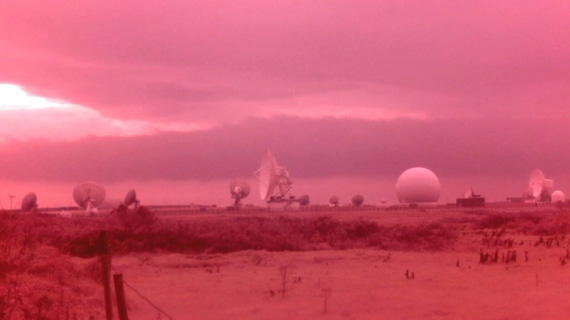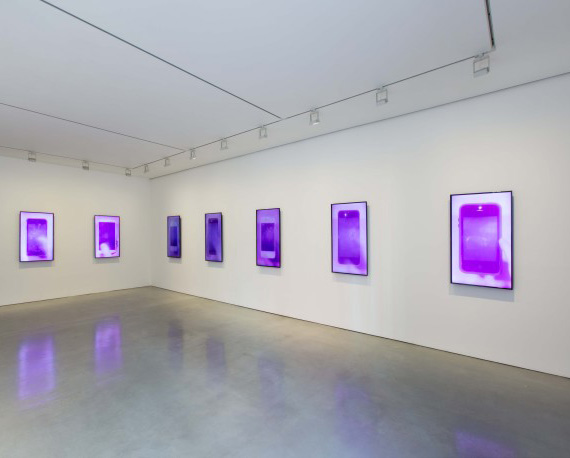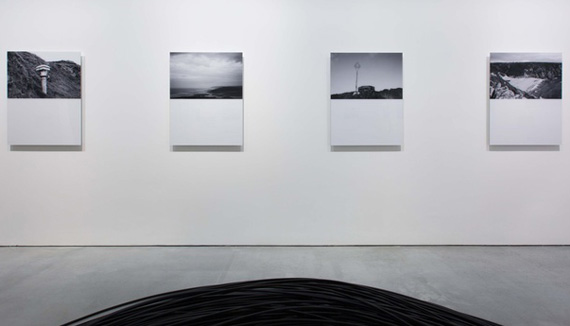
Total Internal Reflection [still], 2015
Single-channel video, 09:46
Evan Roth »
Voices over the Horizon
Exhibition: 6 Mar – 11 Apr 2015
CARROLL / FLETCHER
56-57 Eastcastle Street
W1W 8EQ London
+44 (0)20-7323 6111
info@carrollfletcher.com
www.carrollfletcher.com
Tue-Fri 10-18, Sat 11-18

Dances for Mobile Phones series, 2015
7 monitors, single-channel videos
Left to right: Isabella; Jerome; Kathleen; Karen; Evan; Michele; Christine
When the first transatlantic telegraph cables came ashore at Porthcurno, Cornwall, in 1866, allowing messages to be sent across continents and oceans in a matter of seconds for the first time, many believed they were witnessing the most momentous innovation in human history. For a world that had waited weeks to receive messages across the ocean, it must have seemed like the closest thing to magic to suddenly have access to the instantaneous exchange of communication in the complete absence of physical bodies. Within living memory for many of us today, the advent of email and the Internet struck a similar chord. Indeed, Evan Roth remembers his first experiences with html in the late 90s as brimming ‘with feelings of empowerment and the prospect of unlimited possibilities’. The web offered a free space of untold potential.
Twenty years on, we find an Internet landscape that departs greatly from such utopian expectations. There has been a radical shift away from a decentralised construct of personal websites, forums and peer-to-peer file sharing networks and towards a more centralised system dominated by the likes of Facebook, Amazon and Google. Moreover, the revelations made public by Edward Snowden in 2013 proved beyond doubt that, far from being a free space, today’s Internet has been dramatically affected by government surveillance and corporate interest. It is this jarring loss of innocence toward our relationship with the Internet, coupled with a desire to rediscover those initial feelings of optimism and wonder that provides the impetus behind this exhibition. In its essence, Voices over the Horizon began as an Internet pilgrimage.
In Autumn 2014, Roth set out on a road trip to Cornwall where the early telegraph cables have since been replaced with fibre-optic Internet cabling that is estimated to carry 25% of the world's Internet traffic. In his attempt to re-establish a spiritual connection to this seemingly invisible force swarming all around us, Roth turned to ghost-hunting and specifically ghost-hunting technologies. These strange looking devices, including full spectrum video cameras, thermal flashlights and electronic voice phenomenon recorders, were developed by a close-knit DIY community and not only lent themselves to Internet-focused modifications but also re-kindled a sense of mystery and wonder toward technology that he had not felt in some time. Like his ghost-hunting counterparts whose urgent enquiries into the supernatural were often conducted on sites of assumed paranormal activity, Roth ventured out with his ghost-hunting toolkit into the landscape that physically hosts the Internet, in a personal quest to visualise and reconnect with what has become so integral to contemporary life; making sense of a web which feels less dynamic, less chaotic, more centralised and more controlled.
---
The exhibition opens with the series Dances for Mobile Phones, which presents the surface of a screen as our most immediate access point into the Internet’s physicality. Our mobile touchscreens are perhaps our most intimate connection to the Internet, rarely leaving our sides. Here, video recordings show everyday people performing everyday tasks on their mobile devices. Shot with a full-spectrum infrared and ultraviolet camera built by the Cleveland Paranormal Society to document disembodied human energy, pixels ordinarily visible to the human eye become invisible, and those signals normally invisible are made visible. In obscuring the digital interface, the new and unnatural movements we have adopted become all the more apparent. By contrast, the only illumination visible from the phones is the ordinarily invisible infrared beam, emitted from LEDs in the top section of the phone near the earpiece and used primarily for facial recognition. This illumination is controlled not by the user, but by the device, and displayed together these works prompt the question of who or what is controlling our gestures as well.
The three Web Portal works on paper were created by embossing manhole covers situated near the submarine fibre-optic landing points in the Cornwall area. These specific manhole covers were the nearest to the actual landing locations, and therefore most likely to cover the conduits housing the Fibre-Optic Link Around the Globe (FLAG) cable, until recently the fastest and longest cable in the world. These manhole covers may well be the closest points within public access to the actual laser light that is the Internet. The rubbings presented here act as ritual actions, made through a careful, repetitive process in much the same way as gravestone rubbings.
To the Waters and the Wild relays a YouTube clip of a family on the beach at Porthcurno, with the mechanics of the fibre-optic laser light exposed. The laser beam carrying data is playfully interrupted by a traditionally lucky ‘beckoning cat’, with each stroke of the cat’s paw interrupting the flow of information.
Continuing this metaphorical journey into the workings of the Internet, 2km of direct bury fibre-optic cable make up the monumental work, Burial Ceremony. Generally shipped on large wooden spools, fibre-optic cable must be unspooled before it is placed underground. It is an industry standard best practice to lay the cable out in this figure-of-eight shape in order to prevent twisting and pressure on the fibres, while at once an auspicious form that is commonly held to symbolise infinity.
Along the walls surrounding the cable, an arrangement of black-and-white photographs taken on Roth’s trip document the traces of the physical Internet on the Cornish coastline. Manhole covers, GCHQ satellite dishes, signposts and monuments together create a broken horizon line, perpendicular to the transatlantic cabling under ground and sea. Each photograph is paired with readings from a ghost-hunting device taken at the same location, laser-etched into the surface of the work. The placement and scale of the image and etching mirror the way we commonly view our surroundings: looking out at the expansive horizon before us, and then down at our small, constrained screens.
In the downstairs gallery, Total Internal Reflection connects together a series of moments from Roth’s trip shot with a full-spectrum ghost-hunting camera. The audio for the piece, recorded on location, is drawn from a custom-built instrumental transcommunication device or ‘ghost box’, which scans radio frequencies at regular intervals. Roth built this device himself based on open source schematics supplied by engineers in the paranormal community, premised around the idea that a disembodied force might be able to communicate by arranging these radio snippets to form messages. The scanning of radio static blends with the ambient noises of waves and wind and the warm tones of the images to evoke a powerful sense of place. Similarly, the works in the Sonogram series are each data visualisations of 7 minutes of radio and ambient sound recorded at key locations on the Cornish coast.
Perhaps one of the most surprising discoveries Roth made on his trip was to find that the site where the first transatlantic cables connected with those to Europe is marked by a whitewashed rubble-stone pyramid. Benben is a half-scale recreation and homage to the original. The graphics printed on the outside were generated using a modified hand scanner, originally designed for portable document scanning. The printed material acts both as representation of the original, and as record of the scanning action or ritual, with the uneven surface of the stone combining with the movement of the artist’s hand to result in stretched and compressed scans. The abstract nature of the imagery ensuing from the intentional misuse of the scanning device, creates a rendering of the pyramid that is aptly mediated through the digital.
Online, at voicesoverthehorizon.com, Roth’s investigations take digital form once more. A live stream relays the feed of three handheld ghost-hunting devices placed on a shelf in the centre of the gallery. One device scans radio waves and plays back white noise anomalies. The other two machines pick up on temperature data and electromagnetic frequencies. One converts this information into coloured graphics, while the other uses the same findings to select syllables from a database. In offering up the work as an openly accessible online resource, Roth inserts his findings back into the ghost-hunting community that so inspired him.
Evan Roth (b. 1978, USA) is an artist whose practice visualises and archives culture through unintended uses of technologies. Creating prints, sculptures, videos and websites, his work explores the relationship between misuse and empowerment and the effect that philosophies from hacker communities can have when applied to digital and non-digital systems.
Roth's work is in the permanent collection of the Museum of Modern Art, New York and has been exhibited at various institutions, including the Centre Pompidou, the Kunsthalle Wien, Tate and the front page of Youtube. He has received numerous awards, including the Golden Nica from Prix Ars Electronica, Rhizome/The New Museum commissions and the Smithsonian's Cooper-Hewitt National Design Award.�

Landscape series, 2015
15 laser-etched Lambda prints face mounted on acrylic with dibond backing